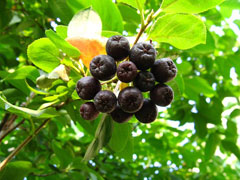Two cultivars of chokeberry - ‘Nero’ and Polish ‘Galicjanka’ are sold in Poland. Sometimes, there are also present the seedlings of ‘Viking’ and ‘Hugin’ cultivars. In the experiment some morphological characteristics, the quality of fruits and chemical composition of four chokeberry cultivars (‘Galicjanka’, ‘Hugin’, ‘Nero’, ‘Viking’) were compared. Chokeberry plants were grown at the Experimental Station of Pomology Department at the West Pomeranian University of Technology in Szczecin. Fruits collected from ‘Hugin’ cultivar shrubs were the smallest (100 fruits weight was 32 g) and the least juice was obtained from them (73.6%); however, they were characterised by the highest content of soluble solids (18.7°Bx), titratable acids (1.05 g), polyphenols (2340 mg), especially cyanidin 3-galactoside as well as nitrates (98.5 mg) and nitrites (1.87 mg). The ‘Hugin’ cultivar was characterised by light-coloured fruits, and, as a result, by light-coloured juice. Fruits of ‘Galicjanka’ cultivar were the biggest, 100 fruits weight was 111,7 g. In fruits of the ‘Nero’ and ‘Viking’ cultivars, the content of individual components was at the lowest level. These cultivars have the largest amount of substances colouring fruits, pulp as well as red and blue juices, are also the darkest and the dark juice was obtained from them. Maceration of fruit pulp resulted in a significant change of colour of the juice obtained, it become darker and had a more intense blue colour.
Full Text: PDF

